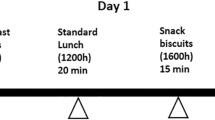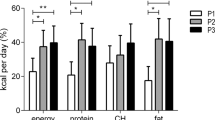Abstract
Objective:
We tested the relative importance of a low-glycemic response versus a high glycemic response breakfast meal on postprandial serum glucose, insulin and free fatty acid (FFA) responses after consumption of a standardized mid-day meal in adult individuals with Type 2 diabetes mellitus (DM).
Design:
Following an overnight fast of 8–10 h, a randomized crossover intervention using control and test meals was conducted over a 3-week-period. A fasting baseline measurement and postprandial measurements at various time intervals after the breakfast and mid-day meal were taken.
Subjects:
Forty-five Type 2 DM subjects completed the requirements and were included in the study results.
Interventions:
Two different breakfast meals were administered during the intervention: (A) a high glycemic load breakfast meal consisting of farina (kJ 1833; carbohydrate (CHO) 78 g and psylium soluble fiber 0 g), (B) a low-glycemic load breakfast meal consisting of a fiber-loop cereal (kJ 1515; CHO 62 g and psyllium soluble fiber 6.6 g). A standardized lunch was provided approximately 4 h after breakfast. Blood plasma concentrations and area under the curve (AUC) values for glucose, insulin and FFA were measured in response to the breakfast and mid-day lunch. Statistical analyses were performed using SAS software (8.02). Comparisons between diets were based on adjusted Bonferroni t-tests.
Results:
In post-breakfast analyses, Breakfast B had significantly lower area under the curve (AUC) values for plasma glucose and insulin compared to Breakfast A (P<0.05) (95% confidence level). The AUC values for FFA were higher for Breakfast B than for Breakfast A (P<0.05) (95% confidence level). Post-lunch analyses indicated similar glucose responses for the two breakfast types. Insulin AUC values for Breakfasts B were significantly lower than Breakfast A (P<0.05) (95% confidence level). The AUC values for FFA were unaffected by breakfast type.
Conclusions:
These data indicate that ingesting a low-glycemic load meal containing psyllium soluble fiber at breakfast significantly improves the breakfast postprandial glycemic, insulinemic and FFA responses in adults with Type 2 DM. These data revealed no residual postprandial effect of the psyllium soluble fiber breakfast meal beyond the second meal consumed. Thus, there was no evidence of an improvement postprandially in the glycemic, insulinemic and FFA responses after the consumption of the lunch meal.
Sponsorship:
This study was supported with an unrestricted grant from Kellogg Company, Battle Creek, Michigan.
This is a preview of subscription content, access via your institution
Access options
Subscribe to this journal
Receive 12 print issues and online access
$259.00 per year
only $21.58 per issue
Buy this article
- Purchase on Springer Link
- Instant access to full article PDF
Prices may be subject to local taxes which are calculated during checkout



Similar content being viewed by others
References
Abraham WT (2004). Preventing cardiovascular events in patients with diabetes mellitus. Am J Med 116 (Suppl 5A), S39–S46.
Anderson JW, Allgood LD, Turner J, Oeltgen PR, Daggy BP (1999). Effects of psyllium on glucose and serum lipid responses in men with type 2 diabetes and hypercholesterolemia. Am J Clin Nutr 70, 466–473.
Bjorck I, Liljeberg H, Ostman E (2000). Low glycaemic-index foods. Brit J Nutr 83 (Suppl 1), S149–S155.
Boden G (1997). Perspectives in diabetes: role of free fatty acids in the pathogenesis of insulin resistance and NIDDM. Diabetes 46, 3–10.
Brouns F, Bjorck I, Frayn KN, Gibbs AL, Lang V, Slama G et al. (2005). Glycaemic index methodology. Nutr Res Rev 18, 145–171.
Friedewald WT, Levy RI, Fredrickson DS (1972). Estimation of the concentration of low-density lipoprotein cholesterol in plasma, without use of the preparative ultracentrifuge. Clin Chem 18, 499–502.
Gannon MC, Nuttal FQ, Westphal SA, Fang S, Ercan-Fang N (1998). Acute metabolic response to high-carbohydrate, high-starch meals compared with moderate-carbohydrate, low-starch meals in subjects with type 2 diabetes. Diabetes 21, 1619–1626.
Garg A, Bantle JP, Henry RR, Coulston AM, Griver KA, Raatz SK et al. (1994). Effects of varying carbohydrate content of diet in patients with non-insulin-dependent diabetes mellitus. JAMA 271, 1421–1428.
Gavin 3rd JR (1999). The importance of postprandial hyperglycaemia. Int J Clin Prac 107 (Suppl), S14–S17.
Gerich JE (2003). Clinical significance, pathogenesis, and management of postprandial glycemia. Arch Intern Med 163, 1306–1316.
Holt SH, Brand-Miller JC, Petocz P (1996). Interrelationships among postprandial satiety, glucose and insulin responses and changes in subsequent food intake. Eur J Clin Nutr 50, 788–797.
Hu FB, Leitzman MF, Stampler MJ, Colditz G, Lui S, Soloman CG et al. (2001). Diet, lifestyle and the risk of Type 2 diabetes mellitus in women. N Eng J Med 345, 790–797.
Jarjis HA, Blackburn NA, Redfern JS, Read NW (1984). The effect of ispaghula (Fybogel and Metamucil) and guar gum on glucose tolerance in man. Br J Nutr 51, 371–378.
Liljeberg HG, Akerberg AK, Bjorck IM (1999). Effect of the glycemic index and content of indigestible carbohydrates of cereal-based breakfast meals on glucose tolerance at lunch in healthy subjects. Am J Clin Nutr 69, 647–655.
Liu S, Willett WC, Stampfer MJ, Hu FB, Franz M, Sampson L et al. (2000). A prospective study of dietary glycemic load, carbohydrate intake, and risk of coronary heart disease in US women. Am J Clin Nutr. 71, 1455–1461.
Mayer-Davis EJ, D'Agostina Jr R, Karter AJ, Haffner SM, Rewers MJ, Saad M et al. (1998). Intensity and amount of physical activity in relation to insulin sensitivity: The Insulin Resistance Athersclerosis Study. JAMA 276, 669–674.
McGarry JD (2002). Dysregulation of fatty acid metabolism in the etiology of type 2 diabetes. Diabetes 51, 7–18.
Pastors JG, Blaisdell PW, Balm TK, Asplin CM, Pohl SL (1991). Psyllium fiber reduces rise in postprandial glucose and insulin concentrations in patients with non-insulin-dependent diabetes. Am J Clin Nutr 53, 1431–1435.
Rendell M (2000). Dietary treatment of diabetes mellitus. N Engl Med J 342, 1440–1441.
Roberts CK, Barnard RJ (2005). Effects of exercise and diet on chronic disease. J Appl Physiol 98, 3–30.
Salmeron J, Manson JE, Stampfer MJ, Colditz GA, Wing AL, Willett WC (1997). Dietary fiber, glycemic load, and risk of non-insulin-dependent diabetes mellitus in women. JAMA 277, 472–477.
Short KR, Vittone JL, Bigelow ML, Proctor DN, Rizza RA, Coenen-Schimke JM et al. (2003). Impact of aerobic exercise training on age-related changes in insulin sensitivity and muscle oxidative capacity. Diabetes 52, 1888–1896.
Sierra M, Garcia JJ, Fernandez N, Diez MJ, Calle AP, Sahagun AM (2001). Effects of ispaghula husk and guar gum on postprandial glucose and insulin concentrations in healthy subjects. Eur J Clin Nutr 55, 235–243.
Sierra M, Garcia JJ, Fernandez N, Diez MJ, Calle AP, Farmafibra Group (2002). Therapeutic effects of psyllium in type 2 diabetic patients. Eur J Clin Nutr 56, 830–842.
Shapiro ET, Polonsky KS, Copinschi G, Bosson D, Tillil H, Blackman J et al. (1991). Nocturnal elevation of glucose levels during fasting in noninsulin-dependent diabetes. J Clin Endocr Metab 72, 444–454.
Wolever TM, Bentum-Williams A, Jenkins DJ (1995). Physiological modulation of plasma-free fatty acid concentrations by diet. Metabolic implications in nondiabetic subjects. Diabetes Care 18, 962–970.
Wolever TM, Josse RG, Leiter LA, Chiasson JL (1997). Time of day and glucose tolerance status affect serum short-chain fatty acid concentrations in humans. J Nutr 127, 1973–1980.
Wolever TM, Mehling C (2003). Long-term effect of varying the source or amount of dietary carbohydrate on postprandial plasma glucose, insulin, triacylglycerol, and free fatty acid concentrations in subjects with impaired glucose tolerance. Am J Clin Nutr 77, 612–621.
Wolever TM, Vuksan V, Eshuis H, Spadafora P, Peterson RD, Chao ES et al. (1991). Effect of method of administration of psyllium on glycemic response and carbohydrate digestibility. J Am Coll Nutr 10, 364–371.
Acknowledgements
We thank Raquel Pereira, MS, RD, Jenifer Fenton, PhD, and Jean Kruger for their invaluable technical assistance. We also wish to acknowledge the technical expertise of Dale Romsos, PhD.
Author information
Authors and Affiliations
Corresponding author
Additional information
Guarantor: NG Hord.
Contributors: RFP, ACG, AS, LE, JK contributed to this work.
Rights and permissions
About this article
Cite this article
Clark, C., Gardiner, J., McBurney, M. et al. Effects of breakfast meal composition on second meal metabolic responses in adults with type 2 diabetes mellitus. Eur J Clin Nutr 60, 1122–1129 (2006). https://doi.org/10.1038/sj.ejcn.1602427
Received:
Revised:
Accepted:
Published:
Issue Date:
DOI: https://doi.org/10.1038/sj.ejcn.1602427
Keywords
This article is cited by
-
Breakfast quality and cardiometabolic risk profiles in an upper middle-aged German population
European Journal of Clinical Nutrition (2017)
-
Identification of the primary mechanism of action of an insulin secretagogue from meal test data in healthy volunteers based on an integrated glucose-insulin model
Journal of Pharmacokinetics and Pharmacodynamics (2013)
-
Glycemic and insulinemic responses to breakfast and succeeding second meal in type 2 diabetics
International Journal of Diabetes in Developing Countries (2011)
-
The effects of psyllium on lipoproteins in type II diabetic patients
European Journal of Clinical Nutrition (2009)
-
Second meal effects of dietary calcium and vitamin D
European Journal of Clinical Nutrition (2008)



